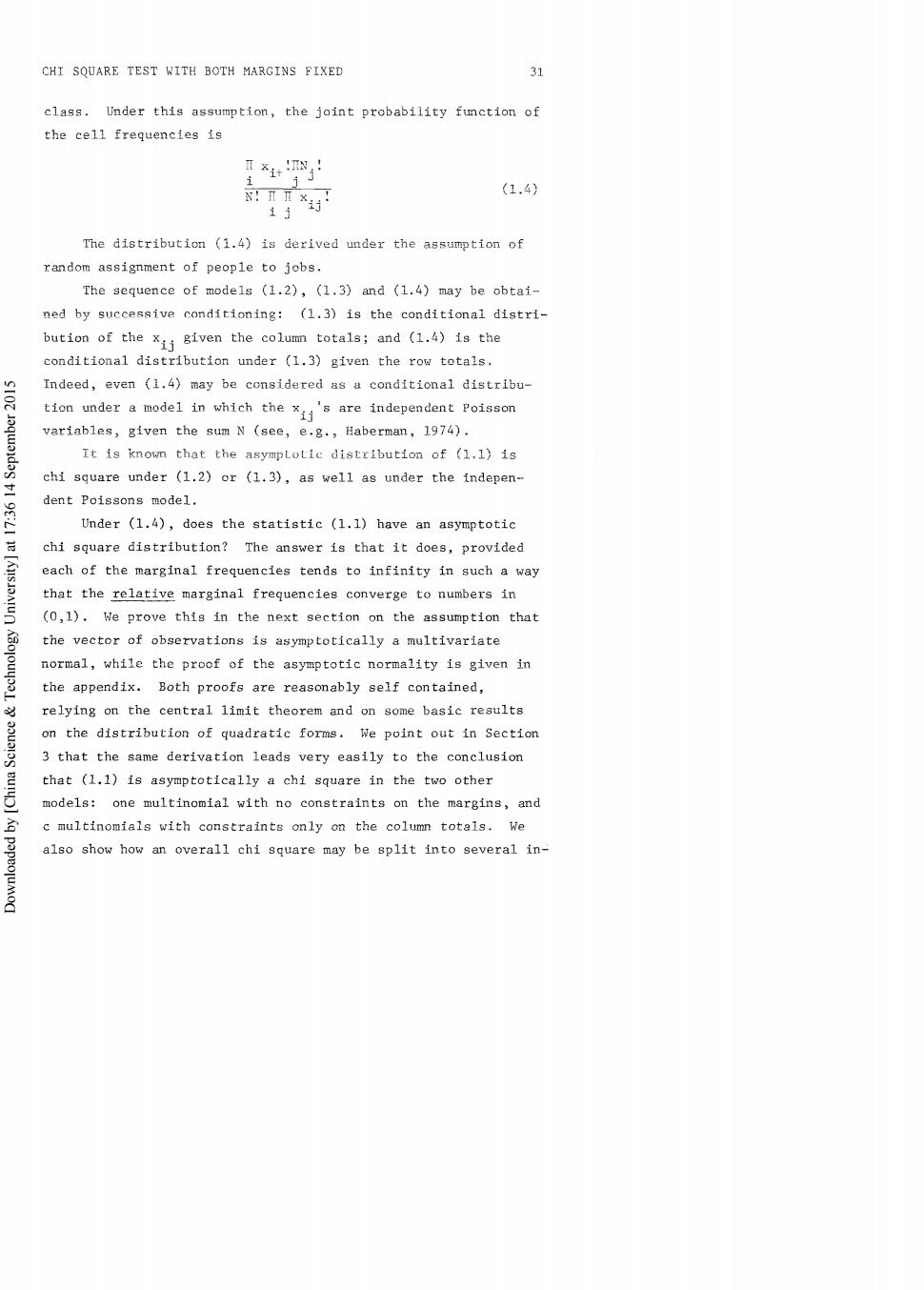正在加载图片...

CHI SQUARE TEST WITH BOTH MARGINS FIXED 31 class.Under this assumption,the joint probability fuction of the cell frequencies is N:可×时 (1.4) ij The distribution (1.4)is derived under the assumption of random assignment of people to jobs. The sequence of models (1.2),(1.3)and (1.4)may be obtai- ned by successive conditioning:(1.3)is the conditional distri- bution of the xij given the colum totals;and (1.4)is the conditional distribution under (1.3)given the row totals. Indeed,even (1.4)may be considered as a conditional distribu- tion under a model in which the x's are independent Poisson variables,given the sum N (see,e.g.,Haberman,1974). It is known that the asympLotic distribution of (1.1)is chi square under (1.2)or (1.3),as well as under the indepen- dent Poissons model. Under (1.4),does the statistic (1.1)have an asymptotic chi square distribution?The answer is that it does,provided each of the marginal frequencies tends to infinity in such a way that the relative marginal frequencies converge to numbers in (0,1).We prove this in the next section on the assumption that the vector of observations is asymptotically a multivariate normal,while the proof of the asymptotic normality is given in the appendix.Both proofs are reasonably self contained, relying on the central limit theorem and on some basic results on the distribution of quadratic forms.We point out in Section 3 that the same derivation leads very easily to the conclusion that (1.1)is asymptotically a chi square in the two other models:one multinomial with no constraints on the margins,and c multinomials with constraints only on the column totals.We papeoluMo also show how an overall chi square may be split into several in-CHI SQUARE TEST WITH BOTH MARGINS FIXED 31 class. Under this assun?tton, the joint probability function of the cell freqcencies Is rho LLxb distribution ti ,,.-; I,? -- 4.: A~-;~.-.,; -- ~ii.?er the .~ssu-ption of random assignment of people to jobs. The sequence of mcdeis (l.2), (1.3) ard (1-4) may he obtained by svcc~ssivr condition in^: (1.3) is the conditional distribution of the xij given "Le column totals; and (1.h) is the - conditional distribution under (1.3) given the row totals, , - ~~d~~d, even ; i, 4) may k- gc. currDLa ----: ' iLc.L, ,.-,-, 2 z~ ii ccnditional <isiributlon under a model in which the xz _ 's are independent ?cisson "J variables, given the sum N (see, e.g,, Haberman, 1974). Ti -- 4, &= 5 : ..Ls.-,9<-L -.-,vr, i:nqh =LL.>% -- 'I- L!22 ~ &>~JL!LEi62ii~ c~l:gkr:L?~?537~ af ('::) i.~ , L - - chi square under (1.2) or (1,3), as well as under the independent Poissons model. Under (1.41, does the statistic (1.1) have an asymptotic chi square distribution'? The answer is that it does, provided each of the marginal frequencies tends to infinity in such a way that the reiative marginai frequencies converge to numbers in 1. We pr~ne this in the nPxt section on the assumption that the vector of observations is asymptotically a multivariate normai, while the prmf of the asymptotic normality is given in the appendix. Both proofs are reasonably self contained, relying on the centrai iimit theorem and on some basic results on the distribution of quadratic £oms. We point out ir-, Sectior, 3 that the same derivation leads very easily to the conclusion that (1.1) is asymptotically a chi square in the two other models: one multinomial with no constraints on the margins, and c multfnomials with constraints only en the coium. totalsi We also show how ari overall chi square may be split into several inDownloaded by [China Science & Technology University] at 17:36 14 September 2015